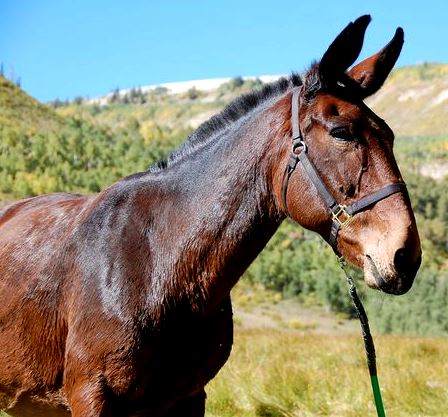Our Immortal Mules
by Joe Goodell

A singular phenomenon, the mule, hybrid off-spring of a donkey (jack) and a horse (mare). The other way around, horse (stallion) and donkey (jennet) gives us the hinny. But time and custom have classified the two together as mules.
Whether mule or hinny, they all have those almost comical long ears, short manes and small hooves, are sterile and can be any color that horses and donkeys come in (except pinto) with some having dark muzzles, thus the “blue-nose” mule. Everyone can sound off with its own disharmony, sliding from something like a whinny to a discordant bray.
It is not clear where mules first appeared, although at some time they came to the attention of George Washington who ardently developed a line of them. He, and many following, favored them over horses for their strength, longevity, and hardiness. Some of the forty-niners in a hurry to claim their gold preferred mules over oxen for their greater speed, endurance, and sure-footedness. For its transport requirements, the US Army proceeded from 19th Century mule drawn wagons, to the faithful DC-3, to the current behemoths of the sky, “full circle” back to dependable mules for crossing the rugged mountains of Afghanistan.
The Southern economy for generations was in an essential partnership with them, a “culture of men and mules.” Some families realized that “all you need, really, is one mule, one plow, and a lot of children.” Folks even named their mules after certain friends and selected acquaintances. “Florence Nightingale” was featured in one of Bill Mauldin’s WWII cartoons as a mule helping to evacuate wounded GI’s.
Before their vast population was displaced in both utility and ubiquity by tractors and trucks, they worked farms throughout the South There were specialties: rice and cotton mules for Mississippi and sugar mules for Louisiana, where straight lines of sturdy mules from here to the other side of yonder excelled in pulling deep running plows for both seeding and cultivation. They came, typically, from Columbia, Tennessee which still hosts an annual Mule Day with pulling contests
There were levee mules, railroad, mine, mountain pack, and logging mules. Between 1871 and 1899 they powered the little “wooden box” street cars along Capitol and State Streets in Jackson, Mississippi. There were all sizes from 36 inches to the 17 hand Mammoth Jack draft animals. They were loyal and patient, and when well treated worked hard, trying always to do their best. The reputation for stubbornness likely came from their refusal to be endangered or worked to death as horses could be. When ill-treated or irritated they could strike out with hooves in any direction, even sideways.
Mules became the stuff of folklore with a prominent place in music celebrated by “Mule Skinner Blues.” They are featured in literature with eloquent praise from William Faulkner in “The Reivers.” He described mules as independent: “a mule which will gallop for a half mile in the direction elected by its rider becomes a legend,” and as intelligent: “an ability to cope with the environment, that is to accept environment, yet still retain something of personal liberty.”

There is a legendary place in this legendary state of Mississippi, perhaps more in the imagination than on any map; Mule Jail it’s called. A serene and fanciful place where mules do, or did reside for protection, not punishment. You may be able to go there if you are lucky enough to know the charming “Alice” and be invited through her special “Looking Glass” into that enchanting lowland waterway set in soft sunlight with unique birds, trees of ancient cypress, of oak and maple draped with hanging moss and, at least in spirit, a few mules.
They are no longer here in the numbers they once were, but remain sharp in memory. The sage of Yoknapatawpha County reminds us how “a mule would work for you, but only within the limits of his own self-set regulations. He will not enter any place unless he knows what is on the other side. He is free of the obligations of ancestry and of the responsibilities of posterity; he has thus conquered both life and death and hence is immortal.”


